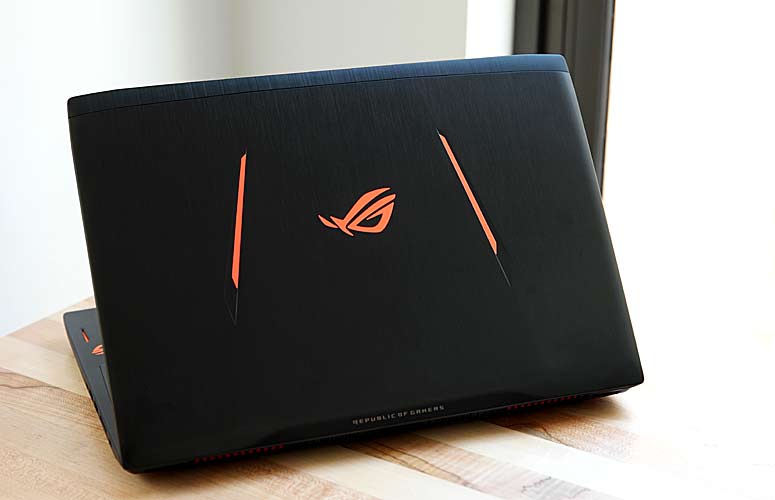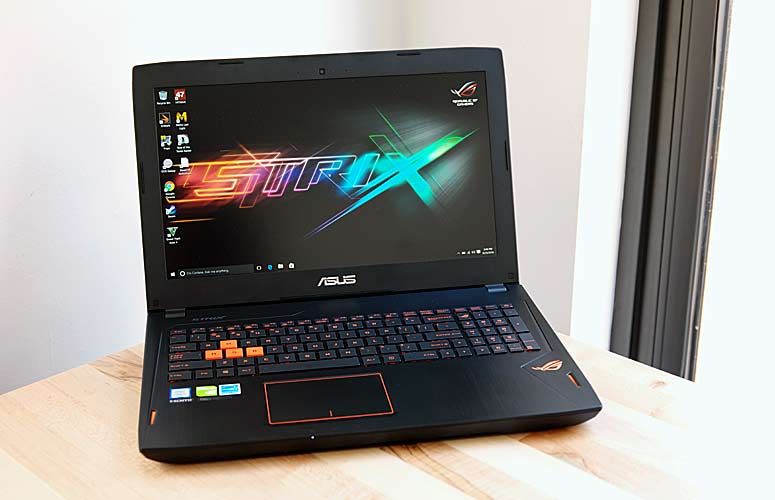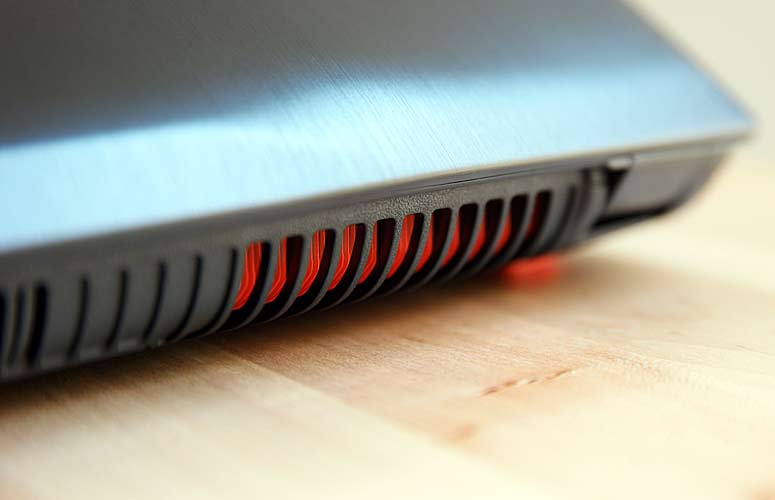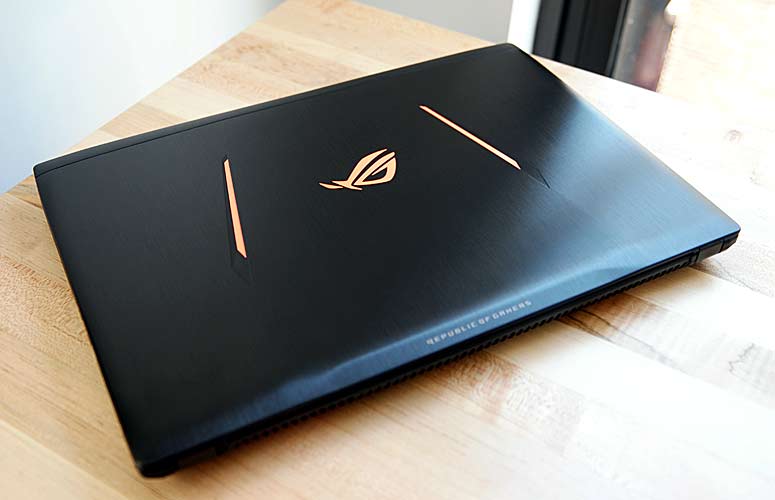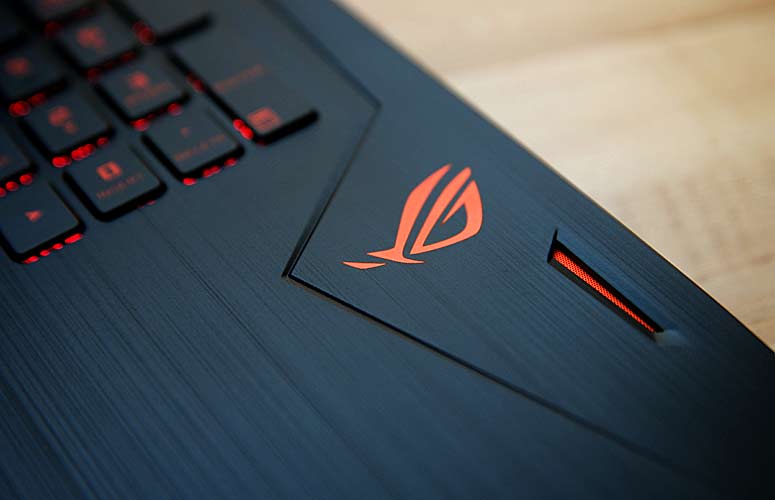Laptop Mag Verdict
The Asus ROG Strix offers a good mix of power and portability, but suffers from poor battery life.
Pros
- +
Great graphics and overall performance
- +
Swift transfer speeds
- +
Pretty G-sync display
Cons
- -
Below-average battery life
- -
Muted audio
- -
Gets hot during gaming/nongaming activity
Why you can trust Laptop Mag
Asus' ROG Strix was already a gaming beast, nabbing a vaunted 4 stars in a previous review. But with its latest refresh, the Strix GL50VS-DB71, the $1,699 notebook is gunning for the top of the gaming-laptop mountain. Armed with its new Nvidia GTX 1070 GPU, the 15-inch Strix is now lean, mean and oh, so VR-ready. However, a short battery life and a few other issues keep the Strix from ascending to gaming-laptop glory.
Design
I'm still not sold on the whole nuclear-orange and black motif the Strix has going. But if I put my hue-based prejudices aside, I can admit that it is a handsome machine. The matte-black, brushed-aluminum is stately despite the nearly glowing neon-orange emblem and accompanying darts. Toward the back of the lid is an understated Republic of Gamers logo. The top of the lid is made of black, brushed plastic.
Lifting the lid reveals a black plastic palm rest with striations mimicking the metal lid. More of that eye-searing orange adorns the deck in small accents along the touchpad and another ROG emblem. The keyboard isn't immune to the glow, sporting orange lettering on the black keys. However, the WASD keys have inverse coloring that's sure to burn into the backs of your retinas.
Along the right of the system, you'll find a pair of USB 3.0 ports, a 2-in-1 card reader, a headset jack and a Kensington lock slot. On the left is a USB 3.1 Type-C port, another USB 3.0 port, HDMI 2.0, a mini DisplayPort and a power jack.
Weighing 5.8 pounds, the 15.4 x 10.5 x 0.9-inch Strix is a middleweight compared to the 5.4-pound Gigabyte P55W v6-PC3D (14.9 x 10.6 x 1.1~1.3 inches) and the 6.8-pound MSI GS63VS Dominator Pro (15.4 x 10.5 x 1.6 inches).
Display
Sign up to receive The Snapshot, a free special dispatch from Laptop Mag, in your inbox.
If you're looking for bold, vibrant color, the Strix's 15.6-inch, 1920 x 1080 display has you covered. Despite, the screen' matte, anti-glare coating, actress Octavia Spencer's cocoa skin looked radiant during the Hidden Figures trailer. Her olive dress popped against the otherwise-drab background. Details were fine enough that I could make out the divots in a golden pin the actress wore.
The Witcher 3: Wild Hunt was even prettier, with its deep green forests, which give way to expansive farms with golden straws of grain. I was particularly taken with the sun as it rose over a nearby windmill turning lazily in the wind.
The Strix's panel reproduces 115 percent of the sRGB color gamut (we consider 100 percent to be excellent). It was better than the 92 percent mainstream average as well as the Dominator Pro (108 percent) and the PW55 (110 percent).
When we tested for color accuracy, the Strix wasn't too far off the mark, at 1.8 on the Delta-E test (0 is ideal), which is noticeably better than the 2.3 average. The PW55 was somewhat better, at 1.8, but the Dominator Pro was the overall winner, at 0.68.
MORE: Best Asus Laptops
Averaging 300 nits on our brightness test, the Strix easily outshone the 270-nit category average. The Dominator Pro was just a bit brighter, at 301 nits, but the PW55 proved to be the brightest, at 321 nits.
G-Sync Goodness
If having a bright, vivid and accurate display isn't enough to tickle your fancy, the Strix's panel also has Nvidia's G-Sync technology. Using proprietary software, it syncs up the laptop's display rate with the graphics card. In other words, the tech is placing a frame cap that matches the panel's refresh limit, allowing for instant rendering in both full-screen and windowed modes. This eliminates any tears, making for smooth images.
Audio
One area the Strix can improve on is its audio. The bass is still somewhat absent, as I discovered listening to Gallant's "Bourbon." The artist's ethereal falsetto was fine, but the synthesized percussion was harsh at higher volumes, as were the keyboards. And speaking of higher volumes, the small pair of orange speakers masquerading as decoration could barely fill our lab with sound.
The audio was not any better when playing games. Almost as soon as I started wandering around Witcher 3, I was in a fight. As I dodged, cast spells and attacked with my sword, the normally energetic fight music with its yelps and handclaps sounded distant. When I unleashed my fire spell, it didn't have the usual big woosh sound with accompanying crackle. I had to plug in a headset to get a semblance of normal audio.
In both cases, I attempted to augment the sound with Asus' preinstalled AudioWizard software. However, I couldn't find a preset (War Room, Battlefield, Multimedia, Action or Soundscape) to fix the more glaring issues.
Keyboard and Touchpad
Though it has a crazy color palette, the Strix also offers a Chiclet-style keyboard with large, flat keys and a full Num pad. With 1.4 millimeters of key travel and 52 grams of actuation, the keys are a little mushy, but I managed to tap out 60 words per minute on the 10FastFingers typing test. It's below my 65-wpm average, but still pretty good for me. The orange backlighting is good enough for me to see the keyboard in a dim room.
The 4.1 x 2.8-inch touchpad was spacious and gave fast, accurate response when I scrolled through web pages or summoned Cortana with a three-finger press.
Gaming, Graphics and VR
The Strix is outfitted with an Nvidia GeForce GTX 1070 GPU with 8GB VRAM. The middle child of Nvidia's new Pascal chips, this GPU offers approximately 35 percent better performance than its predecessor. And just like its 10-series siblings, it has the extra bonus of being VR-capable. When we ran the SteamVR performance benchmark to check the VR-readiness, it hit 10.6, edging out the mainstream average and the Dominator Pro (GTX 1070 GPU), which hit 10.1. The P55W, with its GTX 1060 GPU, notched only 6.6.
During my Witcher 3 play-through, I happened across a crew of bandits. My horse neighed nervously, preparing to rear up and buck me off as I leaned down and lopped off one of my attacker's arms. The bloodied appendage flew through the air at 58 fps on Ultra at 1080p before it landed on the ground with a thud.
The laptop also held its own on our standard benchmarks, nailing down a 77 fps on the Rise of the Tomb Raider test (1080p on Very High), sailing past the 53-fps average along with the P55W (50 fps) and Dominator Pro (51 fps). On the DirectX 12 Hitman test, the Strix achieved 69 fps, matching the average and beating the P55W's score of 57 fps. However, the Dominator Pro struck back with a big 94 fps. The Strix and Dominator Pro were in reach of each other on the Grand Theft Auto test, scoring 61 and 67 fps, respectively, which beat the 52-fps average and the P55W's 33 fps.
Performance
We're all just biding our time until Intel's new Kaby Lake processors come to market. Until then, the Strix's 2.6-GHz Intel Core i7-6700HQ processor with 16GB will do. The laptop streamed an episode of Gotham at full screen while running a full-system scan with 12 additional open tabs in Google Chrome, and it showed no latency.
However, the Strix fell short on the Geekbench 3 test, scoring 12,371, which was enough to top the 7,780 category average. Thanks to their own Core i7-6700HQ CPUs, the Dominator Pro and P55W hit 13,556 and 13,530.
It took 12 seconds for the Strix's 256GB NVMe PCIe SSD to duplicate 4.97GB of mixed-media files during our File Transfer Test, which translates to 424.1 megabytes per second. That was more than enough to decimate the 135.9MBps mainstream average and the P55W's (128GB m.2 PCIe SSD) 128.1MBps, but not the Dominator Pro (256GB m.2 PCIe SSD), which delivered a blistering 628.6MBps.
Battery Life
All that power comes with a price, and in the case of the Strix, it's paid in battery life. The laptop lasted only 2 hours and 39 minutes on our battery test, which is well below the 6:42 average. The Dominator Pro fared somewhat better, tapping out at 3:18.
MORE: Laptops with the Longest Battery Life
Webcam
The integrated 720p webcam is surprisingly color-accurate. My red dress and purple hair were nearly spot-on in the test shots, as were our lab assistant's blonde highlights. However, her white shirt blended in with the wall in the background, eliminating her left shoulder. Details were clear enough for me to know that I need to go get my eyebrows redone.
Software and Warranty
Asus preinstalled a number of apps focused on game optimization and system health. Splendid Utility, for example allows you to change the display's color temperature, so your games, images and videos can look their best. The GameFirst IV software is a network-prioritization app that allows you to monitor and set network bandwidth.
The ROG Gaming Center consists of four customizable profiles that let gamers set specific display and audio settings as well as shut down other applications when launching a specified game or application. You can even check your CPU and GPU temperature and frequency.
If that weren't enough, Asus also added Nvidia's GeForce Experience, which has its own suite of gamer-centric software, including Battery Boost, Game Optimization, ShadowPlay and GameStream.
Third-party apps include Netflix, Candy Crush Soda Saga, Twitter, Music Maker Jam and Trip Advisor.
The Asus ROG Strix ships with a one-year warranty. See how Asus fared in our Tech Support Showdown and where it falls on our Best and Worst Brands list.
Heat
The Strix is a bit of a hot potato. After I spent 15 minutes fighting bandits and wargs in Witcher 3, the laptop's undercarriage hit 123 degrees Fahrenheit, which is well above our 95-degree comfort threshold. The touchpad and the center of the notebook were markedly cooler, at 82 and 93 degrees.
Once the device cooled down, we tried running a full-screen YouTube video for 15 minutes. When it was done, the touchpad and space between the G and H keys hit an acceptable 88 and 94 degrees. The bottom of the notebook measured 102 degrees.
Bottom Line
At $1,699, the Asus ROG Strix GL502VS-DB71 is good for gamers who prize power and portability, but plan to stay plugged in. The 0.9-inch thick chassis means the laptop can be easily slipped into a waiting backpack. And when it's time to play, the svelte assassin has a powerful Intel Core i7 processor and a VR-capable Nvidia GTX 1070 GPU to unleash gaming hell.
But if power is your thing and you don't mind forking out an additional $300, I'd recommend the $1,999 MSI GS63VS Dominator Pro, which has a lovely display in its own right, powerful graphics and overall performance, and some seriously fast transfer speeds. Overall, though, the Strix is a solid choice for gamers on the go.
- Best Dell and Alienware Laptops
- The Best Laptops for Business and Productivity
- The Best Laptops for Every Need
Asus Strix Specs
| Bluetooth | Bluetooth 4.2 |
| Brand | ASUS |
| CPU | 2.6-GHz Intel Core i7-6700HQ |
| Card Slots | 2-1 card reader |
| Company Website | www.asus.com |
| Display Size | 15.6 |
| Graphics Card | Nvidia GeForce GTX 1070 GPU |
| Hard Drive Size | 256GB |
| Hard Drive Speed | n/a |
| Hard Drive Type | NVMe PCIe SSD |
| Native Resolution | 1920x1080 |
| Operating System | Windows 10 |
| Optical Drive | None |
| Optical Drive Speed | n/a |
| Ports (excluding USB) | HDMI, Headset, Mini DisplayPort, USB 3.0, Gigabit Ethernet |
| RAM | 16GB |
| RAM Upgradable to | 32GB |
| Secondary Hard Drive Size | 1TB |
| Secondary Hard Drive Speed | 7200 |
| Secondary Hard Drive Type | HDD |
| Size | 15.4 x 10.5 x 0.9 inches |
| Touchpad Size | 4.1 x 2.8-inches |
| USB Ports | 4 |
| Video Memory | 8GB |
| Weight | 5.8 pounds |
| Wi-Fi | 802.11ac |
| Wi-Fi Model | Intel 8260 2x2 |

Sherri L. Smith has been cranking out product reviews for Laptopmag.com since 2011. In that time, she's reviewed more than her share of laptops, tablets, smartphones and everything in between. The resident gamer and audio junkie, Sherri was previously a managing editor for Black Web 2.0 and contributed to BET.Com and Popgadget.
